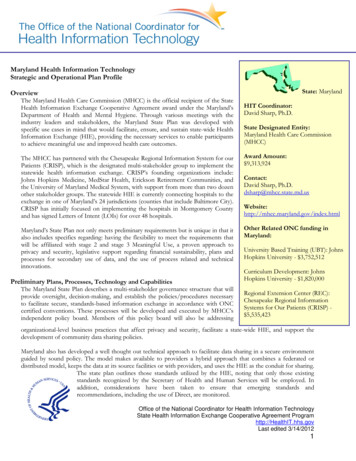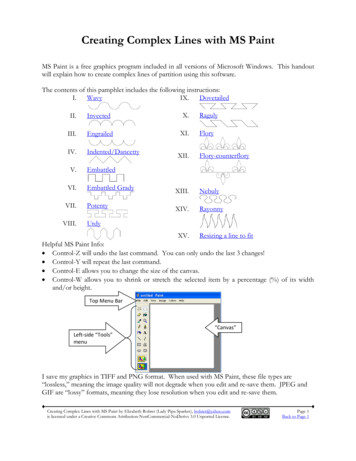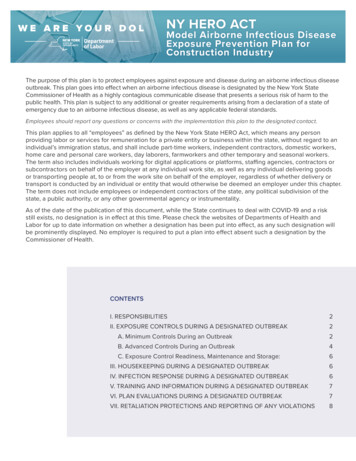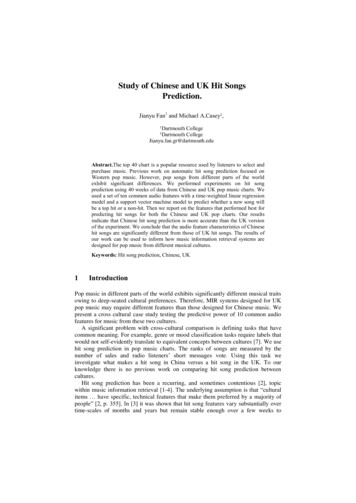
Transcription
Maryland Health Information TechnologyStrategic and Operational Plan ProfileState: MarylandOverviewThe Maryland Health Care Commission (MHCC) is the official recipient of the StateHealth Information Exchange Cooperative Agreement award under the Maryland’sDepartment of Health and Mental Hygiene. Through various meetings with theindustry leaders and stakeholders, the Maryland State Plan was developed withspecific use cases in mind that would facilitate, ensure, and sustain state-wide HealthInformation Exchange (HIE), providing the necessary services to enable participantsto achieve meaningful use and improved health care outcomes.HIT Coordinator:David Sharp, Ph.D.State Designated Entity:Maryland Health Care Commission(MHCC)The MHCC has partnered with the Chesapeake Regional Information System for ourPatients (CRISP), which is the designated multi-stakeholder group to implement thestatewide health information exchange. CRISP’s founding organizations include:Johns Hopkins Medicine, MedStar Health, Erickson Retirement Communities, andthe University of Maryland Medical System, with support from more than two dozenother stakeholder groups. The statewide HIE is currently connecting hospitals to theexchange in one of Maryland’s 24 jurisdictions (counties that include Baltimore City).CRISP has initially focused on implementing the hospitals in Montgomery Countyand has signed Letters of Intent (LOIs) for over 48 hospitals.Award Amount: 9,313,924Maryland’s State Plan not only meets preliminary requirements but is unique in that italso includes specifics regarding: having the flexibility to meet the requirements thatwill be affiliated with stage 2 and stage 3 Meaningful Use, a proven approach toprivacy and security, legislative support regarding financial sustainability, plans andprocesses for secondary use of data, and the use of process related and technicalinnovations.Other Related ONC funding inMaryland:Preliminary Plans, Processes, Technology and CapabilitiesThe Maryland State Plan describes a multi-stakeholder governance structure that willprovide oversight, decision-making, and establish the policies/procedures necessaryto facilitate secure, standards-based information exchange in accordance with ONCcertified conventions. These processes will be developed and executed by MHCC’sindependent policy board. Members of this policy board will also be addressingContact:David Sharp, ryland.gov/index.htmlUniversity Based Training (UBT): JohnsHopkins University - 3,752,512Curriculum Development: JohnsHopkins University - 1,820,000Regional Extension Center (REC):Chesapeake Regional InformationSystems for Our Patients (CRISP) 5,535,423organizational-level business practices that affect privacy and security, facilitate a state-wide HIE, and support thedevelopment of community data sharing policies.Maryland also has developed a well thought out technical approach to facilitate data sharing in a secure environmentguided by sound policy. The model makes available to providers a hybrid approach that combines a federated ordistributed model, keeps the data at its source facilities or with providers, and uses the HIE as the conduit for sharing.The state plan outlines those standards utilized by the HIE, noting that only those existingstandards recognized by the Secretary of Health and Human Services will be employed. Inaddition, considerations have been taken to ensure that emerging standards andrecommendations, including the use of Direct, are monitored.Office of the National Coordinator for Health Information TechnologyState Health Information Exchange Cooperative Agreement Programhttp://HealthIT.hhs.govLast edited 3/14/20121
The coordination between governance and technology will allow for the prioritization and development of use casesthat will drive Maryland’s state-wide HIE capabilities. Maryland’s market readiness assessment has described thestate’s current and capabilities regarding related to meaningful use stage 1, including: electronic prescribing and refillrequests, clinical laboratories sending results electronically, and the exchange of summary of care records. The marketreadiness assessment also described other current and potential future capabilities.Expanding CapabilitiesThe Maryland State Plan also outlines the HIE’s strategy to work with the Maryland Department of Health andMental Hygiene (DHMH) to utilize secondary data that will provide benefits to various local, state, and national publichealth agencies for the purposes of early identification of communicable diseases and population health threats. Thismay include the ability for EHRs or other Health IT to communicate immunizations, syndromic surveillance,notifiable lab results, and other pertinent information to local health departments.The plan also provides an approach to ensure efforts to transform Medicaid through the federally mandated MedicaidInformation Technology Architecture (MITA) architecture are compatible with the vision for HIT in the state andONC. Medicaid and the MHCC are collaborating in the development of the Health Information TechnologyPlanning-Advanced Planning Document (HIT P-APD). These efforts may also assist in information exchange withhealth plans what support electronic eligibility and claims transactions.Addressing Privacy & SecurityPrior to the development of the Maryland State Plan, a workgroup that consisted of eight health care sector groupswas convened to assess business policies and practices in general, and security policies and practices in particular thatcould impede the development of an effective statewide HIE. This assessment included an examination of each sectorgroup’s perception of HIE; concerns regarding the benefits, risks, and challenges impacting each group; and variousalternatives to address these issues. This group along with a MHCC assembled multi-stakeholder workgroup proposeda number of solutions that would guide efforts to establish a statewide HIE. They also assembled a list ofimplementation activities that they believed would guide HIE to a desired future state in Maryland. One of theimplementation activities; recommended the need for separate MPI and Registry databases, which is the preferablemethod, instead of keeping all patient identifying and record locating information in one database.Ensuring Financial SustainabilityThe Maryland State Plan not only presents plans for financially stable state-wide HIE, but the state has committed 10million in funds through its unique hospital all-payor rate setting system. Although grant funding is expected to speedthe implementation of the statewide HIE, the Maryland General Assembly passed legislation (House Bill 706) entitled“Electronic Health Records – Regulation and Reimbursement” that was signed into law on May 19, 2009 byGovernor Martin O’Malley. The law aims at expanding the adoption of EHRs through incentives of monetary valuefrom the six largest state-regulated payors to providers who use certified EHRs capable of connecting to an HIE.In addition, the statewide HIE’s Finance Committee of the Advisory Board is charged with identifying the appropriatecosts of HIE services. The work of this group includes provider surveys and the review of national efforts todetermine price points for services provided by the statewide HIE. Initial funding received through the unique allpayor-rate-setting system will help offset participant costs during the first couple of years of operation. This is in aneffort to ensure pricing stability in the early years of the statewide HIE.Office of the National Coordinator for Health Information TechnologyState Health Information Exchange Cooperative Agreement Programhttp://HealthIT.hhs.govLast edited 3/14/20122
Process & Technology InnovationsThe Maryland State Plan calls for MHCC, in collaboration with its partners, to use Management Service Organizations(MSO). MSOs are approved organizations that provide centralized administrative and technology services and theyallow providers to adopt a hosted certified EHR through a monthly subscription fee. MSOs provide an alternative toexpanding EHR adoption. Under recent legislation, the MHCC is required to designate one or more MSOs by the fallof 2012 and ensure that the technology is compliant with the standards for Meaningful Use.MSOs are considered are considered a viable alternative to the traditional stand-alone EHR client-server model, whichrequires practices to individually negotiate pricing and maintain the technology required to support the software.MSOs are capable of supporting multiple EHR products at reduced costs through economies of scale and bulkpurchasing. MSOs may also be used to support other care-settings beyond inpatient and outpatient and include longterm care, assisted living, and other health care facilities.Office of the National Coordinator for Health Information TechnologyState Health Information Exchange Cooperative Agreement Programhttp://HealthIT.hhs.govLast edited 3/14/20123
Meaningful UseLandscapeStrategyE-PrescribingIn Maryland, provider usage of e-prescribing isslightly more than five percent and around 75 % ofthe 1,628 pharmacies are capable of accepting someform of electronic prescription. This Use Case willimprove the adoption of e-prescribing among themore than 3,102 priority primary care practices inMaryland and this Use Case will be aligned with theincentives available under the American Recoveryand Reinvestment Act of 2009 (ARRA) andimplemented accordingly.The statewide HIE will initially leverage Surescripts as a sourceof medication information derived from both pharmacy dataand claims data. This data will be accessed by routing providerrequests through the HIE to Surescripts and locating the patientusing that company’s MPI service. As the statewide HIEevolves and e-prescribing participants and capabilities evolve,the ability for consumers to maintain medication historyinformation in their own Personal Health Record(PHR)/Health Record Bank (HRB) will be possible.StructuredLab ResultsMaryland exceeds the national rate of computerizedphysician order entry (CPOE) adoption by roughlyseven percent. The implementation of thestructured lab ordering and results use case isexpected to take more than a year to implement asnegotiating connectivity with national, local, andhospital laboratories is expected to be somewhat ofa lengthy process.For primary clinical uses of the information, ancillary data suchas laboratory results will be routed from the processing facility(i.e., laboratory or imaging center) through the statewide HIE tothe ordering physician. In compliance with CLIA, a laboratorywill not be required to seek any additional patient consentbefore transmitting lab results across the HIE to an orderingphysician.Patient CareSummaryMaryland is currently facilitating state-wide HIE.The patient care summary has not been the primaryfocus for information exchange but is scoped forstage 1 Meaningful Use and therefore is addressedby Maryland’s State Plan.Three hospitals, three radiology centers, Quest Diagnostics andthe Laboratory Corp. of America are already participating in theexchange. These specific exchanges and supporting network isand will be managed by CRISP.As per the state plan, Maryland is in the process of developingthe Clinical Summary Exchange Use Case that allows for thesharing of summary clinical data, such as a discharge summary,Continuity of Care Document (CCD), or Continuity of CareRecord (CCR), to assure that health information is sharedamong authorized providers. The information contained in thisUse Case may be constrained by EHR system capabilities. It isalso important to note that practice workgroup information iscross referenced before patient summary data is displayed. Inother words, patient summary data that is displayed may bepractice specific unless consent has been otherwise set by thepatient. This system prevents out-of-practice users fromviewing clinical data to which they have no right. For webservices, authentication and authorization security is providedby WS-security components such as SAML, the X.509 tokenprofile, XML encryption, and XML digital signature.Office of the National Coordinator for Health Information TechnologyState Health Information Exchange Cooperative Agreement Programhttp://HealthIT.hhs.govLast edited 3/14/20124
HIE InventoryStandardsNationwide Health Information Network ExchangeSpecificationsNationwide Health Information Network CONNECTNationwide Health Information Network DIRECTPlans to exchange with federal agencies or other statesvia Nationwide Health Information specificationsQuality ImprovementCare CoordinationXXPublic HealthElectronic lab reporting of notifiable conditionsSyndromic surveillanceImmunization data to an immunization registryPatient EngagementPatient Access/PHRBlue ButtonPatient OutreachXXXXXXAlignment with CLIAXOpt outXXE-PrescribingMedication HistoryIncentive or grants to independentsPlan for controlled substanceSet goal for 100% participationXXControlled substance strategyElectronic eligibility verificationElectronic claims transactionsPlan ModelXTranslation servicesEHR interfacePolicy strategyOrder CompendiumBi-DirectionalXXXAdministrative SimplificationVendorQuality ReportingBehavioral Health Information ExchangeLab StrategyPrivacy and SecurityPrivacy and Security Framework based on FIPSIndividual choice (Opt In/Opt Out/hybrid)Authentication ServicesAudit LogXPlanningCore ServicesXXCare uage Inc.(HLI)Translation servicesCCD/CCR RepositoryXXProvider DirectoryXMaster Patient IndexXRecord Locator ServicesXHealth Plan DirectoryIdentified model(s)Public UtilityInformation for this profile was obtained from the approved Operational and Strategic Plan submitted tothe National Coordinator for Health Information Technology as a condition of the Health InformationExchange Cooperative Agreement. The complete plan can be downloaded at:http://statehieresources.org/.Office of the National Coordinator for Health Information TechnologyState Health Information Exchange Cooperative Agreement Programhttp://HealthIT.hhs.govLast edited 3/14/20125
stage 1 Meaningful Use and therefore is addressed : Continuity of Care Document (CCD), or Continuity of Care ; by Maryland's State Plan. Record (CCR), to assure that health information is shared ; among authorized providers. The information contained in this : Use Case may be constrained by EHR system capabilities. It is











